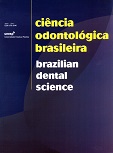Surface roughness of glazed feldspar, alumina, and zirconia-based ceramics
DOI:
https://doi.org/10.14295/bds.2006.v9i4.450Abstract
The aim of this study was to compare the mean surface roughness (Ra) of feldspar-, alumina-, and zirconia-based ceramics, testing the hypothesis that the feldspathic ceramics have lower average surface roughness (Ra) than the ceramics used for infrastructure. Eight disk specimens (5mm in diameter; 2mm in thickness) of each ceramic material were fabricated according to the manufacturer’s specifi cations: V7-feldspathic veneer ceramic (Vita VM7); VA-feldspathic veneer ceramic (Vitadur-α); IA-slip casted, glass-infi ltrated alumina-based ceramic (Vita In-Ceram Alumina); IZS-slip casted, glass-infi ltrated zirconia-reinforced alumina-based ceramic (Vita In-Ceram Zirconia); IZB-dry-pressed block of
glass-infi ltrated zirconia-reinforced alumina-based ceramic (Vita In-Ceram Zirconia 2000 for Cerec InLab). All materials were glazed as recommended by the manufacturer. Four Ra readings (Mitutoyo SJ 400) per specimen were performed, averaging the value per specimen (n=8). Ra values were statistically analyzed using one-way ANOVA and Tukey test (α=0.05). V7 showed the lowest mean Ra value (0.43±0.07 μm) compared to the other ceramics. There were no statistical differences between the mean Ra values of VA (0.94±0.2 μm), IA (0.7±0.13 μm), IZS (0.98±0.3 μm) and IZB (0.75±0.4 μm). The testing hypothesis was partially accepted. V7 showed a smoother ceramic surface than the VA. There were no statistically differences between the mean Ra value of the high crystalline content ceramics (IA, IZS, IZB).
Downloads
Downloads
Published
How to Cite
Issue
Section
License
Brazilian Dental Science uses the Creative Commons (CC-BY 4.0) license, thus preserving the integrity of articles in an open access environment. The journal allows the author to retain publishing rights without restrictions.
=================




























